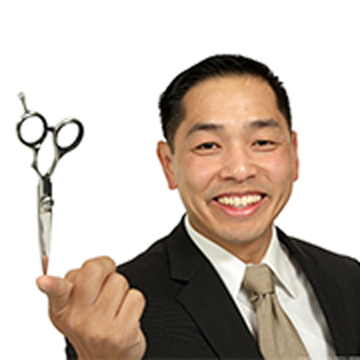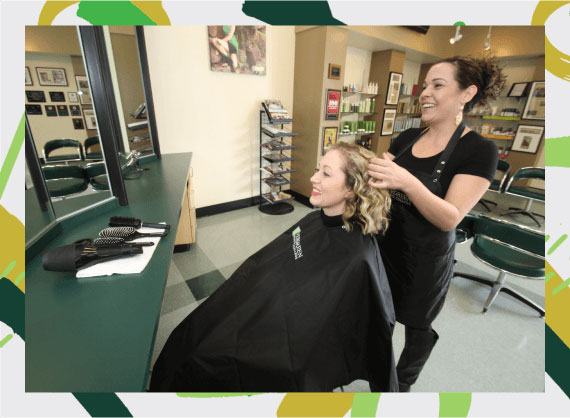How to Make a Career as a Hairstylist
 Hairstyling is a form of art. It’s the kind of endeavor that is not work if you enjoy creating styles, sculpting hair and guiding clients.
Hairstyling is a form of art. It’s the kind of endeavor that is not work if you enjoy creating styles, sculpting hair and guiding clients.
Having a personable approach to the public, and an outgoing creative attitude are good assets. One must have the physical stamina to be able to stand and move about most of the time. It can be a fairly flexible schedule for the person only available part-time.
A hairstylist may be a man or woman, with a deluge of opportunities to practice their art every day. It is also a serious responsibility, not only to fulfill the clients haircut requests. One must have good coordination, excellent listening skills, patience and the ability to follow through. Personality is a large part of success when working with the public. Appreciating the differences in people and knowing how to be tactful is also a necessity.
Where to Study
If you have an interest in a hairstyling career there are many programs to consider. Choices in schools or studies include obtaining a certificate in hairstyling, a diploma from a cosmetology school or a two-year associate degree in cosmetology.
The right curriculum depends on the individual and the kind of education they seek. Usually one must be over the age of 16 and have either a GED or a high school diploma.
Some courses are geared for the novice. One can always return to experience an intermediary or advanced degree in hairstyling.
Each state and hairstyling school vary in the length of time required to graduate, it can be as short as 9 months or as long as 2 years. It all depends on the agenda and the student’s preference.
Here are some of the things you will learn:
 1. Learning scalp massage as a part of a shampoo.
1. Learning scalp massage as a part of a shampoo.
2. Knowing the tools of the trade; combs, brushes, clippers, rollers, electric hair items and more.
3. Learning how to use the tools and care for them.
4. Hair textures, scalp and methods of sanitation and safety concerns for both the stylist and the customer.
5. Using safety materials when handling chemicals, conditioners and other hair products.
6. Practicing on natural hair, such as another student. Attending to wigs is a way to gain experience in styling, coloring and other methods of hair care too.
7. Learning to straighten hair.
8. Knowing different types of hair; thin, thick, coarse, fine textured, long or short require specific processes.
9. Learning to shape, color and pluck eyebrows.
10. Learning how to attach wigs or hairpieces to a patron’s head, cut and style it to the persons’ preference.
11. Braiding, weaving, cutting with a razor and highlighting hair are popular techniques to study.
12. Applying creative ideas in styling.
13. Applying skills in shaving, trimming beards and clipping mustaches.
14. Removing facial hair with the right products and discuss future recommendations.
15. If the customer has a scalp condition, advising them of shampoo or other materials.
16. Learning to apply hair extensions.
17. Learning procedures to curl as well as straighten any hair type.
18. Finding appropriate styles for short or long hair.
19. Knowing how to color hair or lighten hair for a frosted appearance.
20. Determining how to prepare hygienic equipment at the end of the day to maintain and sanitize all materials.
21. Cleaning the station and possibly the salon.
22. Maintaining client records.
23. Adapting to clients, everyone has a unique personality.
24. Following clients instructions, ask for a picture if possible.
25. Focusing on the client for repeat business.
What You Need
 Every state has written tests, some include practical tests, in order to be licensed as a hairstylist or a cosmetologist. The school must also be an approved program by the state in which one works.
Every state has written tests, some include practical tests, in order to be licensed as a hairstylist or a cosmetologist. The school must also be an approved program by the state in which one works.
Each cosmetology school has a particular agenda, but most follow a similar plan after the basic classes and practicing washing, styling and cutting hair.
In order to learn to cut and style hair of all types, ages and genders, one must be familiar with hairstyles for children, men and women. You must also learn how to succeed in interviewing each person in a friendly yet professional manner.
One may begin a career in hairstyling at a franchise or department store salon. Chain stores may pay a salary or an hourly wage. If one prefers an independent salon, booth rent, that is paying for a work station is the norm. As to who pays for the equipment, utilities and supplies, it is possible to negotiate these items with the owner. The renter will receive a commission instead of a salary.
A two year degree at a cosmetology college extends the choices in courses from the practical aspect of hairstyling and all it entails, to advanced classes concerning business management. Perhaps a person is interested in owning his or her own salon. In that case, it is necessary to apply essential skills to personal appearance, salon protocol, business law, bookkeeping and sanitation laws.
A cosmetologist probably will prefer to learn additional skills such as, nail and skin care and proper application of applying make-up. Hair removal and waxing are also an asset in business.
To be a hair industry professional one must learn a great many skills, and hone those abilities in order to move on to other business practices. Beauty shows and seminars that educate skills in management or marketing.
One can create contacts through participating in these kinds of events that may assist in advancing a career in the future.
Phase 2 Learning and Experience
When one reaches the point of moving on from the salon business, cosmetic companies may be the future. Being a consultant or a sales representative for a large company can be a lucrative path, explore options with hair care companies.
Expert weaving and applying extensions is another career entailing an explicit skill.
One could apply the achievements and accomplishments to a day spa as an advisor or in a management position. Some other locations may include cruise ships, theater venues or high-end hotels and resorts.
Who to Know
A professional photographer who does glamour shots, fashion and advertising photography could be a great place for a hairstylist to work or set up shop. For the entrepreneur who likes every aspect of weddings and special events, there is a place for a hairstylist. Perhaps with a little imagination, one could combine the photography studio, wedding hairstyles and make-up as an event business.
Living in a major city offers opportunities for movie sets, modeling/clothing lines and other show businesses. Likewise, if you are in a rural area where salons are sparse, a mobile salon could be an alternative. Setting up a salon in a mobile unit is not difficult with the right tools and a reliable vehicle. Low overhead, independent management and a flexible schedule are all pluses.
Magazine publishing also requires hairstylists and make-up artists. It is an opportunity to display creative and artistic talents for covers and articles/ photos.
Paying for Your Education
Attending school to become a career hairstylist tuition is the same expense as all education. There are alternatives to paying out of pocket though. Grants, scholarships and loans are possible. The American Association of Cosmetology Schools offers guidelines and resources for every subject concerning hairstyling. For motivated individuals pursuing a career in hairstyling there are many options for assistance. This is a short list of favorable connections.
• ACE grants.
• beautychangeslives.org/scholarships
• OPI has an ongoing scholarship program
• beautyschoolsdirectory.com offers $2500 scholarships
• joefrancis.com offers scholarships from the Joe Francis Haircare Scholarship Foundation by Joe Francis and his wife. This couple believes in proposing careers in hairstyling to those who need a hand up.
• Federal Pell Grant, based on need, is very popular.
• FSEOG, a federal education grant is also popular based on first come first served as needed. Apply early.
• Most states have their own grant and scholarship funds available to citizens of that state.
• One must fill out forms with FAFSA before any federal grants will be considered. Go to fafsa.ed.gov
• Some schools have their own grant opportunities, check with the place you plan to attend.
• There are some specific grants for women only, contact the school you plan to attend for more information.
• Veterans services may offer money for education.
• Some club associations will help with a scholarship, such as women’s clubs the BPW and others.
• Student aid may be found at studentaid.ed.gov
• The Alice Madden Barton Cosmetology School Scholarship may be downloaded from that web site.
• paulmitchell.edu also offers a scholarship
• wispine.org offers scholarships for women in serious financial circumstances when leaving an abusive relationship.
Hairstylist careers and hairstylist jobs are plentiful. There is a true demand for talented artistic people willing to work hard to obtain a great career in serving the public, while loving the job they do. It is a demanding job with great rewards for the ambitious person who claims their position in the beauty industry.




